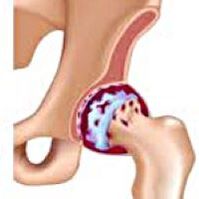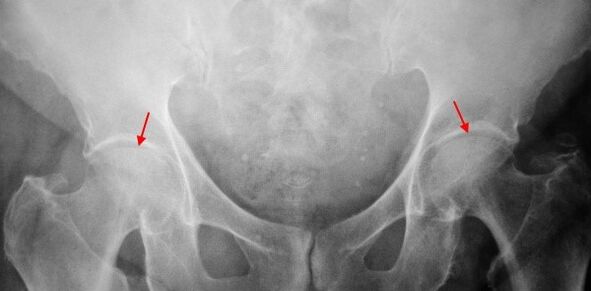Coksartrosis- This is Arthrosis of the hip joint. It grows gradually, in a few years, prone to progress, maybe both and two sides.It comes with pain and limits the movements in the joints.In the later period, hip muscle atrophy and short limbs are observed.The diagnosis is set on the basis of clinical symptoms and X -ray results.In the early stages of COXARTHROSIS, conservation treatment.With joint destruction, especially in young and middle -aged patients, surgery (endrosthetic) is specified.
It grows gradually, in a few years, prone to progress, maybe both and two sides.It comes with pain and limits the movements in the joints.In the later period, hip muscle atrophy and short limbs are observed.The diagnosis is set on the basis of clinical symptoms and X -ray results.In the early stages of COXARTHROSIS, conservation treatment.With joint destruction, especially in young and middle -aged patients, surgery (endrosthetic) is specified.
General information
Coksartrosis (osteoarthritis or joint deformity of hip joints) is a degenerative-degenerative disease.It usually develops at the age of 40 and over.It may be the result of different injuries and joint disease.Sometimes it happens without a clear reason.Coksartrosis is characterized by a gradual progressive course.In the early stages, conservative treatments are used.In the following stages, the general function can only be restored.
In orthopedic and injury, Coxarthrosis is one of the most common arthritis.The high frequency of its development is due to a significant load on the hip joint and the widespread common ratio of congenital disease - joint dysplasia.Women with Coksartrosis are a bit more often than men.
Causes of Coksartrosis
The causes (unknown reasons) and secondary (developed as the result of other diseases) of the hip joint are distinguished.
Secondary Coksartrosis may be the result of the following diseases:
- Hip joint dysplasia.
- Congenitally dislocated thighs.
- Pertes's disease.
- Aseptic necrosis of the thigh tip.
- Infectious lesions and inflammatory processes (for example, arthritis of hip joints).
- Injury (dislocated injury, hip neck fracture, pelvic fracture).
Coksartrosis may be one or two sides.With primary coxarthrosis, a simultaneous lesions of the spine (bones) and knee joints (gonartrosis) are often observed.
Risk factors
Among the factors that increase the ability to develop COXARTHROSIS includes:
- The load increases continuously on the joints.Most are often observed in athletes in people with excess body weight.
- Circulatory disorders, hormonal changes, metabolic disorders.
- The disease of the spine (kyphosis, scoliosis) or stop (flat feet).
- Old age and old age.
- A sedentary lifestyle.
Coksartrosis is not inherited.However, certain characteristics (metabolic disorders, skeleton structural characteristics and weaknesses of cartilage) can be children from genetic parents.Therefore, in the presence of relatives of blood with Coxarthrosis, the probability of the disease occurs a bit increased.
Provide
The hip joint is formed by two bones: ileum and the femur.The head of the thigh is matched with the acetabulum of the pelvis, forming a special hinge.In the movements, acetabulum is still motionless, and the femoral tip moves in many different directions, ensuring bend, expansion, kidnapping, gill and hips.
In the movements, the joint surfaces of the sliding bone are not obstructed compared to each other, thanks to the smooth, elastic and durable hyalin cartilage covering the cavity of the rotating compartment and the thigh tip.In addition, Hyaline cartilage performs shocking function and participates in the reconstruction of load during the movement and walking process.
In the common compartment, there is a small amount of joint liquid, acting as a lubrication and providing nutrition of Hyaline cartilage.The joints are surrounded by a dense and powerful capsule.Above the capsule are large femur and gluteal muscles, providing movements in the joints and, along with Hyalin cartilage, which is also a shock absorbent that protects the joints from wounds with unsuccessful movements.
With Coxarthrosis, the joints become thicker and more viscous.The surface of the hyaline cartilage is dry, loss of smoothness, covered with cracks.Due to the roughness arising, cartilage in the movements are constantly injured with each other, this causes fragility and aggravates the pathological changes in the joints.When Coxarthrosis progresses, the bone begins to deform, adapting to users to increase pressure.The metabolism in the joints is worse.In the later stages of Coxarthrosis, the serious atrophy of the painful muscles is observed.
Symptoms of coxarthrosis
The main symptoms of the disease include joint pain, groin, thighs and knee joints.In addition, with Cokesartrosis, the hardness of the movement and stiffness of the joints, disturbing the gait, disturbance, hip muscle atrophy and short limbs on the side of the lesions are observed.A characteristic feature of Coksartrosis is a restriction of the abduction (for example, the patient is very difficult to try to sit down on the chair).The presence of certain signs and their severity depends on the COXARTHROSIS phase.The first and most certain symptoms are pain.
InCoksartrosis of level 1Patients complain about periodic pain, which occurs after physical activity (running or walking for a long time).The pain is located in the joints, less often in the thighs or knees.After rest, it often disappears.Gaid for Coxarthrosis of level 1 is not broken, the movements are fully preserved, without muscle atrophy.
On the X -Ray of the patient with Coxarthrosis at level 1, the slight changes are determined: The uneven narrowing of the joint distance, as well as the development of the bones around the outer or inside of acetabulum when there is no change from the head and neck of the femur.
InCoksartrosis 2 degreesThe pain becomes more intense, often appearing when resting, radiating into the thighs and groin.After significant physical activity, the patient with Coksartrosis began to limp.The mass of movement in the joints decreases: the abduction and rotation inside the thighs are limited.
In the image of x -ray for the Coxarthrosis of level 2, the uneven narrowing of the joint distance (more than half of the normal height) is determined.The thigh tip has changed, deformed and increased in size, and its borders become uneven.Bone growth with this COXARTHROSIS level is not only inside but also at the outer edge of acetabulum and goes out of cartilage.
InCoksartrosis 3 degreesThe pain becomes unchanged, the patient's worries are not only during the day, but also at night.Walking is difficult, when moving, a patient with Coksartrosis was forced to use a stick.The mass of movement in the joints is limited, the muscles of the buttocks, hips and lower legs are atrophy.The weakness of eliminating the muscles of the thigh becomes the cause of the pelvic deviation in the front plane and shortening the limbs on the pain.To make up for shortening, a patient with Coksartrosis, when walking, tilting the body with pain.Because of this, the center of the gravity shifts, the load on the joints increases sharply.
On the X -ray for Coxarthrosis of level 3, the narrowing of the joint distance, a significant expansion of the thigh tip and the development of many bones were detected.
Diagnose
Diagnosis of Coxarthrosis is based on clinical signs and data of additional studies, which is X -ray.In many cases, X -Rays can set up not only the degree of Coxarthrosis, but also the cause.Therefore, for example, the increase of the diahyseal corner, scenes and flatten acetabulum shows that dysplasia, and changes in the shape of the feminine part of the femur are indicated that Coksartrosis is the consequence of pertes or youthful molecules.On the X -ray of patients with Coxarthrosis, changes may also be detected to show injuries.
Because other tool diagnosis methods of COXARTHROSIS, CT and MRI can be used.Computerized taboos allows you to study detailed pathological changes with bone structures in detail and magnetic resonance images that provide opportunities to evaluate disorders with soft tissues.

Distinguish diagnosis
First of all, COXARTHROSIS should be distinguished from gonarthrosis (joints of the knee joint) and osteoarthritis of the spine.Muscle atrophy, occurring in 2 and 3 stages of COXARTHROSIS, can cause pain in the knee joint, often given brighter than pain in the damaged area.Therefore, for patients' complaints about knee pain, clinical (testing, touching, determining movement volume) is a study of hip joints and if suspected of Coxarthrosis, to direct patients to X -ray.
Pain for pasomolysis syndrome (compression of nerve roots) for osteoarthritis and some other diseases of the spine can imitate pain with Coxarthrosis.Unlike Coxarthrosis, when the root is squeezed, the pain suddenly, after the movement fails, a sharp turning point, lifting weight, etc., is located in the buttocks and spread along the back of the thigh.A positive symptom of stress was detected - severe pain when the patient tried to raise straight, lying on his back.At the same time, the patient freely put his leg aside, while in patients with Coksartrosis, the abduction is limited.It should be noted that osteoarthritis and Coksartrosis may be observed at the same time, so in all cases, careful testing of patients is necessary.
In addition, Cokesartrosis is distinguished from Trochanter (boot burst) - aseptic inflammation in the area that connects the gluteal muscles.Unlike Coxarthrosis, the disease grows rapidly, within 1-2 weeks, usually after a significant injury or physical activity.The intensity of the pain is higher than Coksartrosis.The limitations of motion and shortening limbs are not observed.
In some cases, with a typical process of disease or reactive arthritis, symptoms like Coxarthrosis may be observed.Unlike Coxarthrosis, with these diseases, the pain is at night.Pain syndrome is very intense, may be reduced when walking.Morning hardness is characteristic, happening right after waking up and gradually disappearing within hours.
Coxarthrosis treatment
Treatment of pathology is to participate in orthopedic doctors about injury.The selection of treatments depends on the symptoms and the stage of the disease.In the stage 1 and 2 of Coxarthrosis, conservation therapy is made.In a more serious period of COXARTHROSIS, injection blocks, anti -inflammatory drugs (pyroxes, indomethacin, diclofenac, ibuprofen, etc.) are used.It should be noted that the drugs of this group are not recommended for a long time, as they can have a negative impact on internal organs and prevent the ability of Hyalin cartilage to recover.
To restore damaged cartilage for Coksartrosis, the amounts from a chondroprotector group (chondroitin sulfate, cartilage extract, etc.) are used.To improve blood circulation and eliminate spasms of small vessels, vasodilators (zinnarisine, nicotine acid, pentoxifillin, xanthinol nicotine) are prescribed.According to indications, muscle relaxants are used (muscle relaxation drugs).
With stubborn pain syndrome, patients with Coksartrosis can be prescribed organs using hormonal drugs (hydrocortisone, triamcinolone, metrumor).Steroid treatment must be done carefully.In addition, with Coxarthrosis, local products are used - warm ointments have no clear treatment, however, in some cases, they reduce muscle spasms and reduce pain due to their distraction.In addition, with COXARTHROSIS, the physiotherapy procedures are prescribed (glowing, ultrasound treatment, laser treatment, UHF, thermal power, magnetic therapy), massage, manual therapy and gymnastics.
Coksartrosis diet has no independent treatment and is only used as a means to lose weight.Reducing body weight allows you to reduce the load on hip joints and thus, creating favorable conditions for the Coksartrosis process.To reduce the load on the joint, the doctor, depending on the degree of Coxarthrosis, you may recommend walking with sugarcane or crutches.
In the following stages (with COXARTHROSIS at level 3), the only effective treatment is activity - replacing joints destroyed by laparoscopy.Depending on the nature of the lesion, one of the two parts (only replacing the head of the thigh) or two - -NO (replacing both the head of the thigh and the rotating compartment) can be used.
Endoprosthetic activity for Coxarthrosis is done as planned, after complete inspection, under the whole body anesthesia.During the postoperative stage, antibiotic therapy is performed.The connection lines are removed for 10-12 days, then the patient is prescribed outpatient treatment.After Endoprosthetic, rehabilitation measures must be organized.
In 95% of cases, surgical intervention to replace joints with Coxarthrosis ensures a complete recovery of spending function.Patients can work, actively move and even play sports.The average service life of the prosthetic leg, following all recommendations, is 15-20 years.After that, a second activity was required to replace a worn endocrine.
























